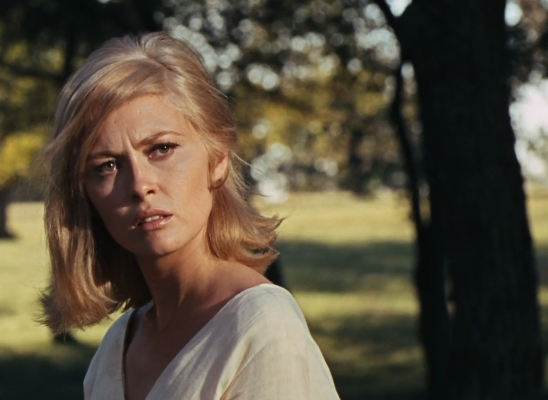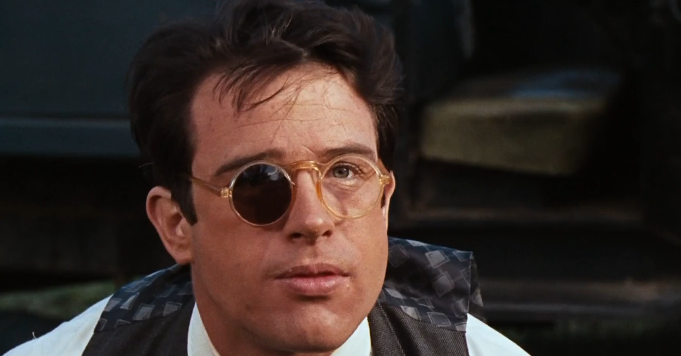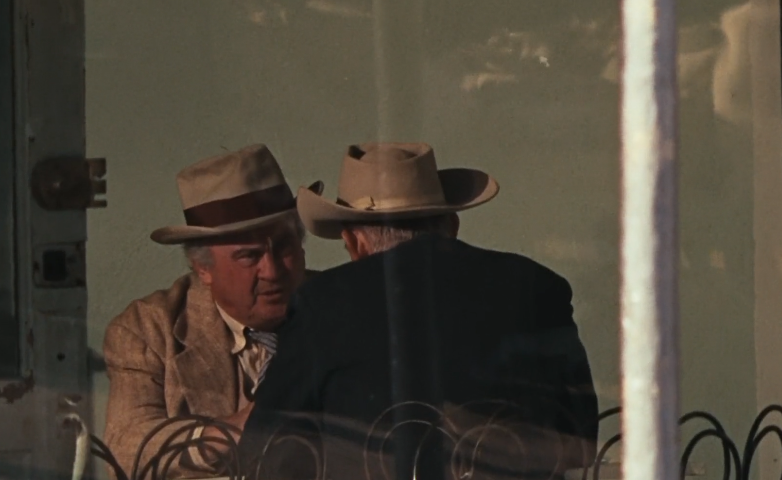Cast
Warren Beatty – Clyde Barrow
Warren made his debut as a tortured teenager opposite Natalie Wood in Splendour in the Grass in 1967. He played a lot of drama, mystery and crime roles, in movies such as Bugsy, The parallax View.

Faye Dunaway – Bonnie Parker
Her career began in the early 1960s on Broadway. She made her screen debut in 1967 in the Happening, the same year she mad Hurry Sundown with an all – star cast, and rose to fame with her portrayal of outlaw Bonnie Parker. She played many role of the female lead in romantic films and also crime fiction. She was mainly unknown before starring in the film Bonnie and Clyde.

Michael J. Pollard – C.W. Moss
Pollard was unknown before his fascinating entry in Bonnie and Clyde, bringing his squint and grin to the part of C.W Moss. He gained a cult following, usually portraying quirky, off beat, simplistic but likeable supporting characters. He played in our movies such as The Wild Angels, Hannibal Brooks.

Gene Hackman – Buck Barrow
For much of 1960s, Hackman was playing small roles on television shows. It wasn’t until his turn as Clyde Barrow’s Older brother in 1967’s Bonnie and Clyde, his first big movie role, that hackman began to really embody a movie star. He starred in roles which contained drama, dark comedy and thriller.

Estelle Parsons – Blanche
During the 1960s, Parsons became known her career on Broadway becoming a movie actress. She is best know for her roles in the movie Bonnie and Clyde, Rachel, Rachel and I never sang for my Father.

Denver Pyle – Frank Hamer
He first screen credit came in 1947, when he landed a small role in the high sea adventure “devil Ship” He worked steadily throughout the 1950s, appearing in the Western anthology series “Frontier” and on the popular family series “My Friend Flicka.” Although he acted primarily in western and crime television dramas.

Dub Taylor – Ivan Moss
Taylor made his film debut in 1938 as the cheerful ex – football captain Ed Carmichael in Frank Capra’s You can’t Take it With you. During 1950s and early 1960s, he used his xylophone skills on several televisions show.

Gene Wilder – Eugene Gizzard
He began his career on stage, and made his screen debut in an episode of the tv series The play of The Week in 1961. His first role was that of a hostage in the 1967 motion picture Bonnie and Clyde. He is best know for his role in Charlie and the Chocolate Factory.

Mise En Scene
Location
– During New Hollywood there where many low budget film. Meaning that many sets where natural environment and place where there was no need for major change. During Bonnie and Clyde many scene where filmed in location that where realistic and verisimilitude for people creating a positive atmosphere for people from that time period.

Sets
– Most sets where filmed in Texas, as Bonnie and Clyde where from Texas. however the built sets where built in the Warner Brother Studio in California. The sets that where built looked realistic do the time and where built to look like other location in Texas.

Costumes
– The most iconic looks from the film, Bonnie and Clyde leaned heavily on the classics. Clyde’s pinstripe double- breasted suit was tailored to perfection, while her ribbed knit sweater, tweed pencil skirt, silk scarf and wool beret where criminally chic. The costume Faye Dunaway wore where very typical of the time period of 1950s and 1960s and the costumes where inspired by many, and was nominated for an Oscar that year for costume design. The film was made in the 1960s however was made to look like the 1940s which was when the real Bonnie and Clyde was robbing banks.

Props
– Props where used to show the time period of the film, the type of car used was many ford enthusiasts regard it as one of the most delicate designs by ford. There was also many props used in the banks scenes where the props made the scene come to life including the use of the gun and bags when collecting money from the cash registers.
Editing
Being an action and emotional film, the editing style that was used a lot was shots of the characters gazing at each other, this was used by Penn to make the audience sympathise with them. Jump cuts used inspired by the French New wave directors like Jean-LucGdard and Francois Truffaut show Penn’s film school background. Use of shot-reverse-shot in the diner conversation the simplistic editing and use of close ups encourages the audience to focus on the dynamic between the characters as Clyde is revealed to be insightful and intuitive. The editing was more visible editing.The opening scene of Bonnie and Clyde uses mainly close up shots of the Bonnie. There are no establishing shots used in the opening scene. However, we can gather information from many props in the scene. The fist shot is an extreme close up, then pans to her in a mirror. Then there is a cut and shows a medium shot of her shoulders and up. When she is on her bed the shot is used to make her feel trapped and mimics the way you would feel trapped in jail. At times in the film, the shots are very unconventional and inspired by French new wave however sometimes does included editing from classical Hollywood which is important to the story.

Sound
Every time the group makes a quick getaway, a chorus of Banjo music, a Bluegrass song called “foggy mountain breakdown” begins to play that evokes time from the Great Depression. The music is quick and light- hearted, and even when the plot has been dramatic, the folksy music makes the scene feel more humours, comic and upbeat. This recurring motif suggests to the audience that to Bonnie and Clyde and their components, crime is all a mater of fun and games. . A score is used when Bonnie and Clyde are driving away from their first robbery. The music is a fast – paced tune played by Banjo. However the lack of music during the actual Robbery scenes lends them a sense of realism.
The mood changes from the banjo style music which shows a comic and humorous tone, to no music where Frank Hamer, who is hunting for Bonnie and Clyde, which shows the seriousness and the change in atmosphere going on. We can tell from the stop in music that something bad might happen.

Sound Bridge – is when a sound is played from scene to another scene. Dede Allen ( editor of Bonnie and Clyde) was an innovator of the Sound Bridge and they get used a lot in the film.
Foley Sound ( diegetic sound ) – The shootouts are typically loud and violent and the loudness of the sound effect is deliberate, and is very elevated for the audience and makes the audience aware of the scene.
Aesthetics
Very diverse shot types, varying pace and discontinuity edits – the lack of clear patterns convey the unpredictability of New
Hollywood and the film’s protagonists. Inspired by Kurosawa’s Seven Samurai for the closing scene of the film. Influenced by convention challenging French New Wave directors. Truffaut even made contributes to the script. There was a lot of verisimilitude location and costumes which felt very comfortable for the audience of that generation.
Representations
Class – Bonnie and Clyde support the working classes throughout e.g. encouraging the evicted Otis Harris to shoot at the bank sign, letting the man in the bank robbery keep his own money.
People of Colour –

Women – Bonnie Parker starts the film feeling trapped and almost as if she is in jail and she doesn’t have much of a life, the extreme close up on her lips almost sexualises her and suggest this film will explore her identity, persona and characteristics. However, throughout the film Bonnie’s persona changes and becomes one of villainess protagonist go against her identity at eh start. Other than the start of the film Bonnie become comfortable with Clyde and shows her brave self off. She challenges the traditional Femme Fatal as she is the one rescuing other people and she is not in the need for rescuing by men, although she breaks taboo of the time by initiating intimacy with Clyde.
Blanche who is Buck’s wife is shown as being more vulnerable and a more realistic version of a Femme Fatal, who need constant reassuring and rescuing by the other gang members.

Men – Clyde is being represented as a strong male character. Clyde is represented as being a forerunners. Clyde helps Bonnie to show herself and others who she really is and who she wants to become, and not what other people want her to be. Clyde’s impotence, ‘I ain’t much of a lover boy”, was also a taboo subject and challenged stereotypes of the masculine virile hero.
C.W Moss importance to the plot of the film and to the gang in general is that he is loyal and idiocy. C.W moss is seen as being like a five year old kids for example parallel parking during one of the bank robbery scenes. When he finds out that Bonnie and Clyde would be killed he looks at them with great amount of sorrow and it shows he cares for them and he has a good heart.
Political and Social Context
The film was released at a time of social unrest in America when people, particularly the young, were challenging the government’s role in the Vietnam war, there were race riots
and a large counterculture developing. The film’s anti-authority message reflected this.
the 1950s was a decade marked by the post World war ll boom, the dawn of the cold war and civils right movement in the united states.
The story of Bonnie and Clyde, the notorious twosome who went on a viscous crime spree during the Great Depression was retooled to reflect the turbulent late 1960s society. Bonnie and Clyde’s anarchic rebellion resonated with a society in the midst of intense Vietnam war and civils right protests.